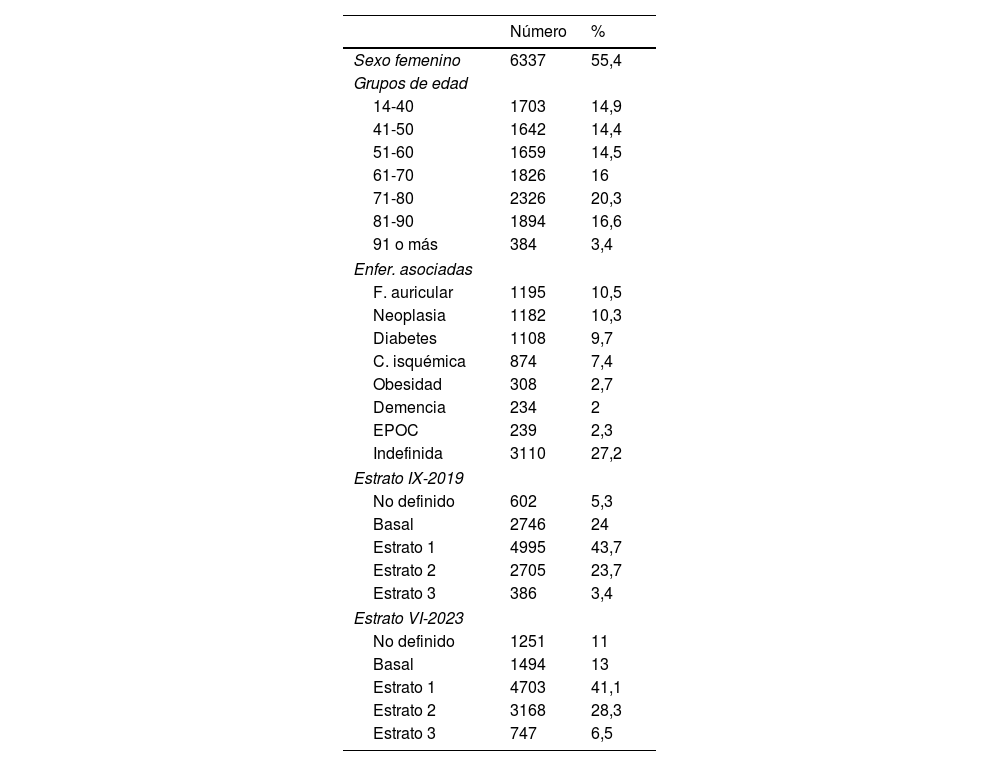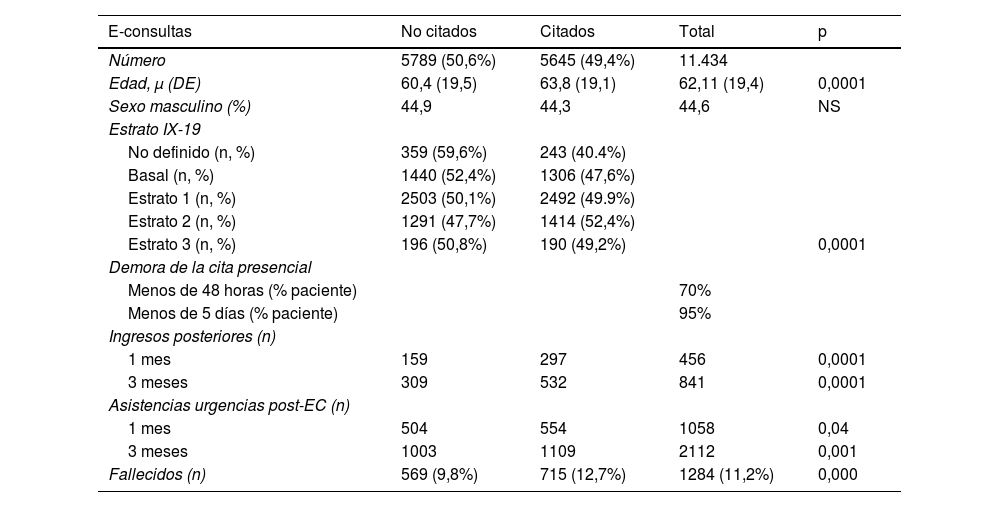Evaluar si la consulta electrónica (e-consulta) es una herramienta clínicamente útil y segura en la valoración de pacientes entre Atención Primaria y Medicina Interna.
MétodosEstudio retrospectivo de cohortes de la totalidad de e-consultas remitidas desde Atención Primaria a un Servicio de Medicina Interna entre septiembre de 2019 y diciembre de 2023. Se evaluaron los resultados de las primeras consultas, las visitas a Urgencias e ingresos posteriores, la supervivencia y se revisaron las quejas y reclamaciones presentadas.
ResultadosSe registraron 11.434 e-consultas (55,4% mujeres) con edad media 62,1 (DE 19,4) años y gran dispersión (15 a 102 años). El tiempo medio de respuesta fue de 2,55 (DE 1,6) días y, como consecuencia, se citaron presencialmente 5645 pacientes (49,4%). En los 5789 (50,6%) restantes se ofreció una respuesta escrita. Entre los citados, el tiempo hasta la valoración presencial fue inferior a 5 días (95% de los casos). Con respecto a los no citados, los citados eran de mayor edad (p<0,0001), acudieron más veces a urgencias (al mes p=0,04; 3 meses p=0,001), ingresaron más veces (al mes p<0,0001; 3 meses p<0,0001) y mostraron mayor mortalidad al año (12,7% vs. 9,8%; p<0,0001). En el análisis de Cox solo la citación presencial (RR=1,11; p=0,04) y la edad (RR=1,09; p<0,01) fueron factores independientes de mortalidad. No se registraron quejas o reclamaciones de ningún tipo.
ConclusionesNuestros datos sugieren que la e-consulta es una herramienta clínicamente útil y segura en la valoración de pacientes remitidos desde Atención Primaria a Medicina Interna.
This work aims to evaluate whether electronic consultations (e-consults) are a clinically useful, safe tool for assessing patients between primary care and internal medicine.
MethodsThis is a retrospective cohort study of all e-consults ordered by the Primary Care Department to the Internal Medicine Department between September 2019 and December 2023. The results of initial consultations, emergency department visits and subsequent admissions, and survival were assessed and complaints and claims filed were reviewed.
ResultsA total of 11,434 e-consults were recorded (55.4% women) with a mean age of 62.1 (SD19.4) years and a wide range (15 to 102 years). The mean response time was 2.55 (SD 1.6) days. As a result of the e-consults, 5,645 patients (49.4%) were given an in-person appointment. For the remaining 5,789 (50.6%), a written response was provided. Among those given appointments, the time between the response and in-person appointment was less than five days (95% of cases). Compared to those not given appointments, in-person appointments were older (p<0.0001), visited the emergency department more times (one month: p=0.04; three months: p=0.001), were admitted to the hospital more times (one month: p=0.0001; three months: p=0.0001), and had higher mortality at one year (12.7% vs. 9.8% p=0.0001). On the Cox analysis, only in-person appointments (RR=1.11; p=0.04) and age (RR=1.09; p<0.01) were independent factors of mortality. No complaints or claims of any kind were registered.
ConclusionsThese data suggest that e-consults are a clinically useful, safe tool for assessing patients referred from primary care to internal medicine departments.
Article
Diríjase desde aquí a la web de la >>>FESEMI<<< e inicie sesión mediante el formulario que se encuentra en la barra superior, pulsando sobre el candado.

Una vez autentificado, en la misma web de FESEMI, en el menú superior, elija la opción deseada.

>>>FESEMI<<<









